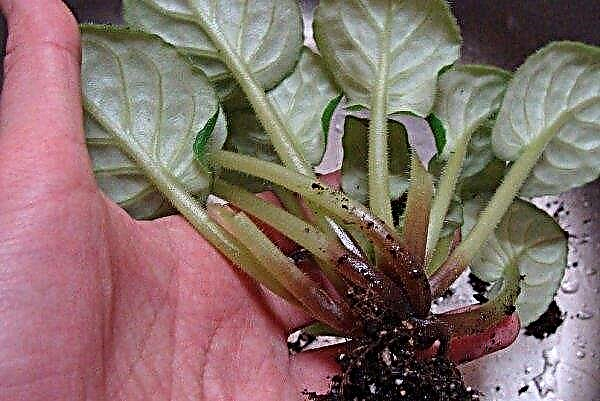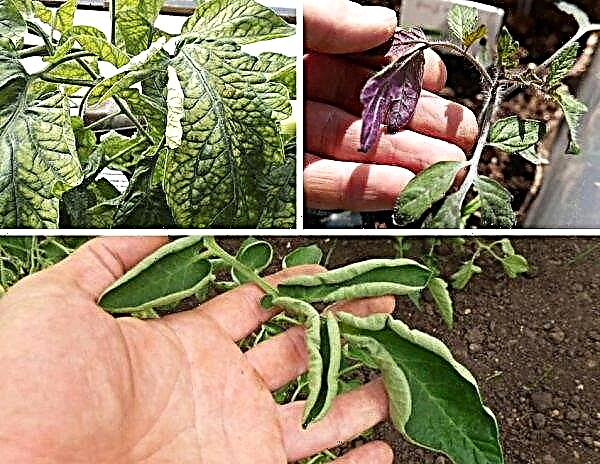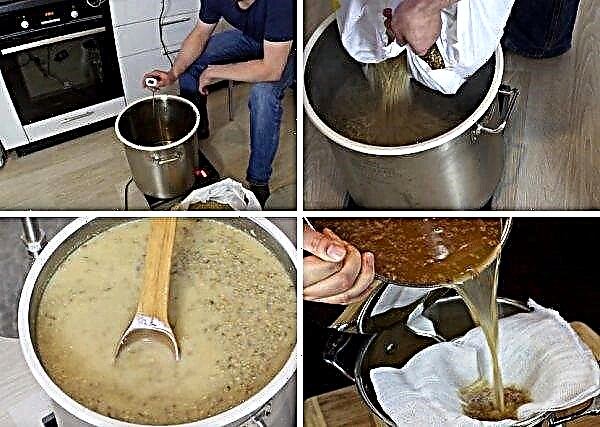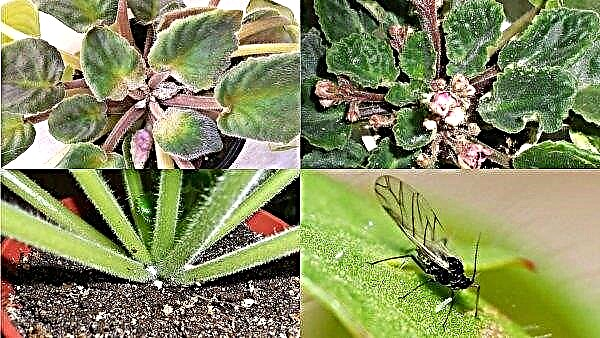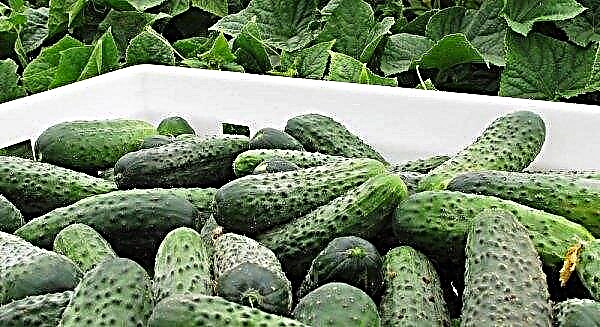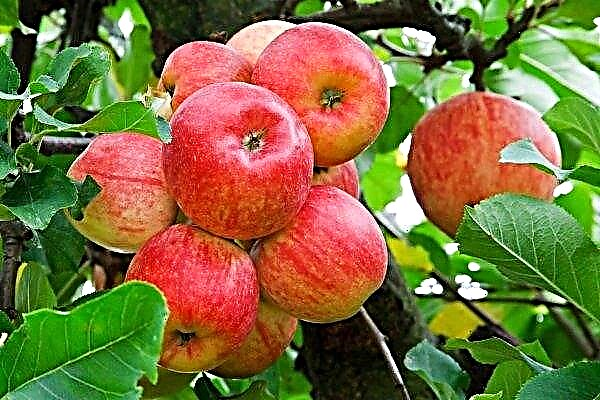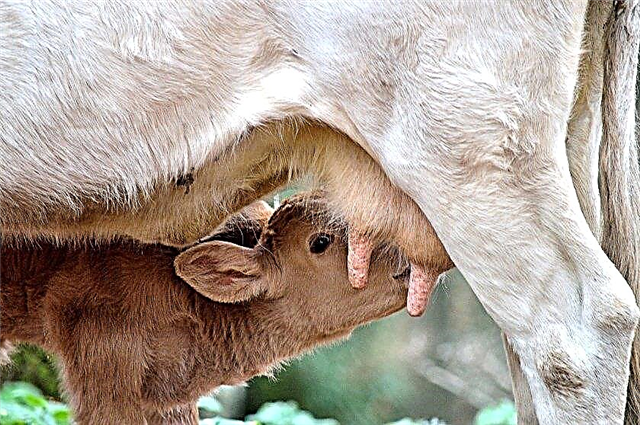Gooseberry is a berry common in the middle zone, which is resistant to temperature extremes and has good fruiting regardless of weather conditions. Consider one of the best varieties of gooseberries - Amber with a detailed description, characteristics and technology of planting seedlings on the site.
Selection history
Work on the creation of the Amber variety was carried out in the 50s. 20 tbsp. in Moscow TSHA. For breeding, the free pollination method was used, the parent variety is English yellow. The author of gooseberry Amber is the famous breeder M.A. Pavlova.

Description
The adult bush of gooseberry cultivar Amber has a height of at least 1.5 m and sprawling shoots. The stems of the plant are slightly leafy, with a small number of large spikes. Leaf blades are small, light green in color, with slightly dissected lobes and bent ends.
Did you know? Kiwi is the fruit of cultivated Chinese gooseberries (actinidia).
Berries of the Amber variety are quite large, reach a weight of at least 5 g, have an elongated oval shape, a strong skin covered with a small amount of glandular hairs. During the ripening period, the surface of the berry acquires a rich amber hue, which fully corresponds to the name of the variety.

The pulp has a light yellow color, very juicy and delicate, with a pleasant sweet taste and honey aroma. Weather conditions affect the level of sweetness, in sunny warm weather the sugar level reaches 11%, with a less favorable summer - at least 8%.
Did you know? The most useful is the immature gooseberry. Green fruits very well remove radionuclides from the body.
Advantages and disadvantages
- Amber variety is very popular among gardeners, due to the large number of positive qualities that are presented:
- excellent taste of fruits;
- high and stable productivity;
- early ripening varieties;
- good transportability;
- the absence of problems shedding berries from the bushes;
- resistance to fruit cracking, even during rains;
- high immunity of plants, resistance to common diseases;
- high winter hardiness and drought tolerance;
- the versatility of the use of fruits;
- high viability of the bushes - up to 30 years, the plant can actively grow and bear fruit.
- Among the disadvantages of the variety can only be distinguished:
- high density of the peel;
- the need for garter long shoots.
Drought resistance, frost resistance
The Yantarny variety has good resistance to summer drought, normally withstands the long absence of rain and artificial irrigation. Gooseberry itself is a frost-resistant crop, but Yantarny has improved resistance to frost and can withstand a drop in air temperature in winter to -40 ° C.

The root system with prolonged and severe frosts does not suffer at all, but it is possible to freeze the shoots of the plant, which did not bend to the soil and did not heat up.
Productivity and fruiting
Gooseberry Amber belongs to the early ripening varieties, gooseberry comes into bearing at the age of 2 years. The berries ripen early, the fruiting period falls on:
- end of June-beginning of July in the middle lane;
- beginning of June in the south;
- late July-early August in the northern regions.

High yields make the variety attractive for industrial and domestic cultivation. The amount of harvested from 1 bush is about 10 kg per season.
Landing
Gooseberry planting is a simple procedure, however, the correctness of its implementation greatly affects the quality of fruiting of a future adult plant, so we will consider when and how to plant plants on a site at home.
Video: Planting gooseberries
The timing
Gooseberry seedlings can be planted both in spring and in autumn, however autumn planting is preferable, since not guessing with dates in spring is fraught with death or poor growth of bushes. In the fall, gooseberries are recommended to be planted a month before the first frost, therefore, depending on the region, the planting period will differ significantly.
In the northern regions, landing is carried out at the end of August, in the southern - at the end of September, in the middle lane - in the middle of September.
Choosing the right place
Gooseberries prefer to grow in a well-lit area, in the shade it will not be possible to get a large crop. The plant does not tolerate the high occurrence of groundwater, therefore, in marshy areas, seedlings are placed on elevations, organizing a thick drainage layer. Light nutrient soils — sandy loam, loam, chernozem — are best suited for cultivation.
 Arrange the plants so that on the north side they are protected from strong wind by stands or structures.
Arrange the plants so that on the north side they are protected from strong wind by stands or structures.
Selection and preparation of planting material
Choosing a good gooseberry seedling is better in a nursery or in a specialized store, so as not to buy a sick, low-quality plant. When buying, pay attention to the root system of the seedling, which should have at least 3 lignified strong processes, about 10 cm long, and a large number of small roots.

It is better to acquire a young plant for planting at the age of 1 year, at which time it usually has 1 central shoot, but this is enough for normal growth in open ground. It is also possible to plant a 2 year old seedling that has 2 to 3 powerful shoots 30 cm long.
Important! Gooseberries do not require special preparation for planting, but if after purchase the plant is not immediately planted in the ground, it is better to dig it into moist soil so that the root system does not dry out.
Landing pattern
The Amber variety has a spreading large bush, which forces gardeners to observe a special planting scheme when performing the planting procedure in open ground. A distance of 2 m should be observed between the bushes, at least 3 m of free space between the rows should be left to ensure normal access to the shoots for ease of harvesting and care of the bush.
 The size of the landing pit should correspond to the dimensions of the root system, usually dig a hole at least 50 cm in diameter and 40 cm in depth.
The size of the landing pit should correspond to the dimensions of the root system, usually dig a hole at least 50 cm in diameter and 40 cm in depth.
Features of seasonal care
Seasonal gooseberry care is the key to good growth of bushes and abundant fruiting, so we will consider the main agrotechnical methods used for bushes at home cultivation.
Soil care
Loosening the soil is necessary once every 2 weeks, this procedure will avoid the formation of crust, remove weed vegetation, which interferes with the normal growth of gooseberries. The depth of cultivation should be 10 cm in the row-spacings and up to 6 cm in the near-stem circle, so as not to damage the surface roots of the gooseberry.
After weeding, it is better to mulch the area with wood sawdust, peat or straw, which will allow for a long time to retain moisture in the soil after watering and prevent the rapid growth of weeds. The thickness of the mulch layer should be about 7 cm. Excess moisture affects the normal development of gooseberries, and it suffers short-term drought quite easily, so frequent bush irrigation is not required.
 The root system of gooseberries is located in the upper and lower layers of the soil, therefore, the roots can be provided with oxygen by regular loosening of the trunk circle.
The root system of gooseberries is located in the upper and lower layers of the soil, therefore, the roots can be provided with oxygen by regular loosening of the trunk circle.
To maintain the required soil moisture, it is recommended to observe the following irrigation scheme:
- the first time the plants are watered after flowering, during the formation of the ovary;
- the second - during a period of active growth and a noticeable change in the color of the fruit;
- the last time water-charging irrigation is carried out in the process of preparing bushes for wintering, in late September.
Watering is carried out with water at room temperature (30 l under one bush) in pre-dug, shallow trenches around the perimeter of the crown of the plant.
Important! It is forbidden to water the bush under the root - this leads to wetting of the neck of the bush and the development of the process of root decay.
Preventative treatment
It is much easier and faster to cope with the preventive treatment of gooseberry bushes than to treat the problem, therefore, special attention should be paid to the timely conduct of the procedure. To prevent the development of gooseberry diseases, bushes are sprayed with fungicides in early spring or autumn.
Common drugs include Topaz and Fundazole. These funds have a wide range of actions, which helps protect gooseberries from all common diseases. Use the preparations according to the instructions on the packaging.
 To get the maximum effect from the use of drugs, it is necessary to strictly observe the dosage and follow the instructions for use, which is indicated on the package.
To get the maximum effect from the use of drugs, it is necessary to strictly observe the dosage and follow the instructions for use, which is indicated on the package.
Insecticides are used against pests, which prevent the defeat of all parts of the bush. Preventive spraying should be carried out 1 time per season, during the appearance of the leaves. The best complex-acting insecticides include Lepidocide, Bitoxibacillin, and Actellic.
Top dressing
Given that the gooseberry Amber abundantly bears fruit, it is recommended to additionally feed it to stimulate the active fruit ovary.
As a fertilizer, a standard complex of organic and mineral components is used, which includes:
- rotted manure - 10 kg;
- superphosphate - 80 g;
- nitrate - 40 g;
- potassium chloride - 20 g.

This complex is applied 2 times a year for each bush:
- after flowering to stimulate the ovary;
- after harvest to prepare the bush for laying flower buds for the next year.
Support
Gooseberry garter allows for the vertical growth of the bush, simplifies maintenance and harvesting, and also protects the young plant from the risk of damage by a strong wind. It is better to perform the procedure immediately during planting, installing a support in the form of a wooden stake or a metal support in the landing pit. It is necessary to fix the shoots to the support with shreds of natural fabric or with a special economic plait.
Pruning
The young plant is pruned a little annually to stimulate the growth of new shoots. The trimming length is ½ of the stem. In addition, every autumn, sanitary removal of old, diseased or damaged shoots, as well as stems that grow inside the bush and greatly thicken it, is carried out.

Adult specimens should have no more than 8 fruit shoots that are able to provide a stable yield. The fruit shoots grow old over time, the quantity and quality of the ovary decreases, so they are promptly removed under the root, replacing young stems growing from the base of the bush.
Harvesting and storage
There are 2 degrees of gooseberry maturity - technical and consumer. Technical ripening of the berry occurs 10 days before full. At this time, the berry begins to acquire a characteristic amber color, but still remains quite dense and sour. Such berries are suitable for long-term storage, transportation and processing. Fully ripe fruits are harvested for immediate consumption or making jam, jam, when it is necessary for the berry to boil well.
 The harvesting period for each region is different, picking fruits starts in June and ends in September. The weather for picking berries should be dry and warm in order to maximize the duration of storage of the crop.
The harvesting period for each region is different, picking fruits starts in June and ends in September. The weather for picking berries should be dry and warm in order to maximize the duration of storage of the crop.
It is necessary to pick fruits by hands, keeping the stalk. Berries should be stored in special fruit crates, not more than 5 kg each. In a state of full maturity, the crop can be stored in cold, ventilated rooms for about 4 days, at temperatures from 0 ° C to + 5 ° C. Harvested fruits in a state of technical maturity are stored for about 10-15 days.
Winter preparations
It is necessary to begin preparing gooseberries for winter in the fall, after the fruiting of the plant is over and the foliage is completely dumped. First of all, it is necessary to remove all leaves and weeds from the site to protect the bush from infection by diseases and pests that winter well under a thick layer of plant debris.
 Next, the soil around the bush is mulched with a thick layer (10 cm) of humus or peat, which will protect the roots of the bush from freezing.
Next, the soil around the bush is mulched with a thick layer (10 cm) of humus or peat, which will protect the roots of the bush from freezing.
Breeding methods
Gooseberries can be propagated in several ways:
Diseases and Pests
Gooseberry Amber rarely suffers from diseases and pests, however, improper care or non-compliance with planting recommendations can provoke a temporary decrease in immunity, which leads to the appearance of pests in the bushes or the development of some diseases. Therefore, we consider what to do in such a situation and how to save the plant from death.
Among the common pests that can sometimes appear on gooseberry bushes, there are:
- aphids - a small insect that settles on the shoots of gooseberries in large colonies and feeds on plant juices. It provokes deformation, slows down plant growth, and causes low productivity. In the fight against aphids, drugs such as Intavir, Fufanon, Arrivoaccording to the instructions;

- glass box - the caterpillar settles inside the shoots, feeds on their core, provokes the withering of the ground part of the bush and its death. You can get rid of the pest with the help of drugs Lepidocide and Bitoxibacillinthat are used according to the instructions.

Diseases that can affect gooseberries are presented:
- powdery mildew - has a fungal nature of origin, becomes the cause of the appearance of gray or off-white powdery coating on berries and leaves. The use of drugs against powdery mildew should be done as soon as the first signs of the disease appear, otherwise the plant may die. The best drugs in the fight against this problem are "Topaz", "Hom";

- rust - a fungal disease that affects gooseberry leaves, sometimes covering the ovaries with yellow or red spots. Against the disease, Bordeaux fluid is used, according to the instructions;

- mosaic - a viral infection that affects all parts of the plant, leads to the death of the bush, is able to infect the entire plantation. At the first signs of a disease, the plant is immediately destroyed so as not to infect neighboring bushes, since there are no drugs to treat the mosaic.

Thus, Amber is an excellent gooseberry variety for growing both in small adjoining territories and on industrial plantations due to the good quality of berries and consistently high yield indicators.







